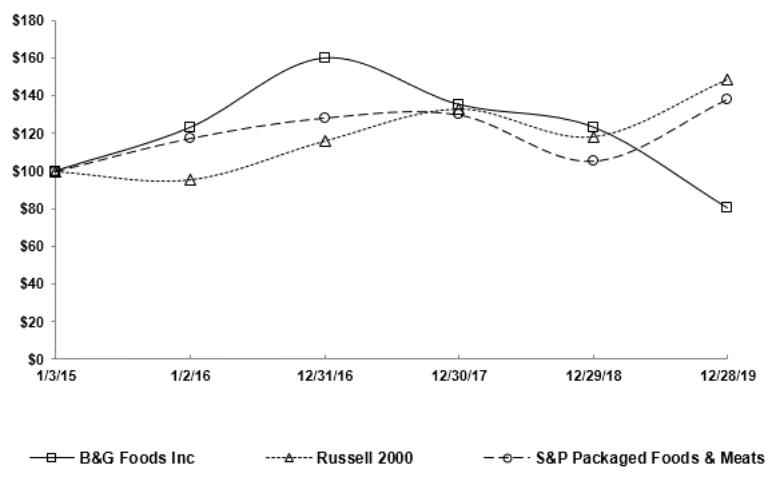Organization and Nature of Operations
B&G Foods, Inc. is a holding company whose principal assets are the shares of capital stock of its subsidiaries. Unless the context requires otherwise, references in this report to “B&G Foods,” “our company,” “we,” “us” and “our” refer to B&G Foods, Inc. and its subsidiaries. Our financial statements are presented on a consolidated basis.
We operate in a single industry segment and manufacture, sell and distribute a diverse portfolio of high-quality shelf-stable and frozen foods across the United States, Canada and Puerto Rico. Our products include frozen and canned vegetables, oatmeal and other hot cereals, fruit spreads, canned meats and beans, bagel chips, spices, seasonings, hot sauces, wine vinegar, maple syrup, molasses, salad dressings, pizza crusts, Mexican-style sauces, dry soups, taco shells and kits, salsas, pickles, peppers, tomato-based products, cookies and crackers, baking powder, baking soda, corn starch, nut clusters and other specialty products. Our products are marketed under many recognized brands, including Ac’cent, B&G, B&M, Back to Nature, Baker’s Joy, Bear Creek Country Kitchens, Brer Rabbit, Canoleo, Cary’s, Clabber Girl, Cream of Rice, Cream of Wheat, Davis, Devonsheer, Don Pepino, Durkee, Emeril’s, Grandma’s Molasses, Green Giant, JJ Flats, Joan of Arc, Las Palmas, Le Sueur, MacDonald’s, Mama Mary’s, Maple Grove Farms of Vermont, McCann’s, Molly McButter, Mrs. Dash, New York Flatbreads, New York Style, Old London, Ortega, Polaner, Red Devil, Regina, Rumford, Sa-són, Sclafani, SnackWell’s, Spice Islands, Spring Tree, Sugar Twin, Tone’s, Trappey’s, TrueNorth, Underwood, Vermont Maid, Victoria, Weber and Wright’s. We also sell and distribute Static Guard, a household product brand. We compete in the retail grocery, foodservice, specialty, private label, club and mass merchandiser channels of distribution. We sell and distribute our products directly and via a network of independent brokers and distributors to supermarket chains, foodservice outlets, mass merchants, warehouse clubs, non-food outlets and specialty distributors.
Sales of a number of our products tend to be seasonal and may be influenced by holidays, changes in seasons/weather or certain other annual events. In general, our sales are higher in the first and fourth quarter. We purchase most of the produce used to make our frozen and shelf-stable canned vegetables, pickles, relishes, peppers, tomatoes and other related specialty items during the months of June through October, and we generally purchase the majority of our maple syrup requirements during the months of April through August. Consequently, our liquidity needs are greatest during these periods.
Fiscal Year
We utilize a 52-53 week fiscal year ending on the Saturday closest to December 31. The fiscal years ended December 28, 2019 (fiscal 2019), December 29, 2018 (fiscal 2018) and December 30, 2017 (fiscal 2017) contained 52 weeks each.
Business and Credit Concentrations
Our exposure to credit loss in the event of non-payment of accounts receivable by customers is estimated in the amount of the allowance for doubtful accounts. We perform ongoing credit evaluations of the financial condition of our customers. Our top 10 customers accounted for approximately 59.1%, 56.9% and 55.8% of consolidated net sales in fiscal 2019, 2018 and 2017, respectively. Our top 10 customers accounted for approximately 62.3%, 55.8% and 51.7% of our consolidated trade accounts receivables as of the end of fiscal 2019, 2018 and 2017, respectively. Other than Walmart, which accounted for approximately 25.6%, 24.1% and 24.1% of our consolidated net sales in fiscal 2019, 2018 and 2017, respectively, no single customer accounted for more than 10.0% of consolidated net sales in fiscal 2019, 2018 or 2017. Other than Walmart, which accounted for approximately 29.1%, 24.9% and 22.4% of our consolidated trade accounts receivables as of the end of fiscal 2019, 2018 and 2017, respectively, no single customer accounted for more than 10.0% of our consolidated trade accounts receivables as of the end of fiscal 2019, 2018 and 2017. As of December 28, 2019, we do not believe we have any significant concentration of credit risk with respect to our consolidated trade accounts receivable with any single customer whose failure or nonperformance would materially affect our results other than as described above with respect to Walmart.
During fiscal 2019, 2018 and 2017, our sales to foreign countries represented approximately 7.7%, 7.3% and 6.3%, respectively, of net sales. Our foreign sales are primarily to customers in Canada.
